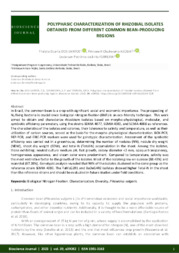Polyphasic characterization of rhizobial isolates obtained from different common bean-producing regions.
Polyphasic characterization of rhizobial isolates obtained from different common bean-producing regions.
Author(s): SANTOS, T. D. dos; ASOBIA, P. C.; FERREIRA, E. P. de B.
Summary: In Brazil, the common bean is a crop with significant social and economic importance. The prospecting of N2 fixing bacteria is crucial since biological nitrogen fixation (BNF) is an eco-friendly technique. This work aimed to obtain and characterize rhizobium isolates based on morpho-physiological, molecular, and symbiotic efficiency parameters, using the strains SEMIA 4077, SEMIA 4080, and SEMIA 4088 as references. The characteristics of the isolates and colonies, their tolerance to salinity and temperature, as well as their utilization of carbon sources, served as the basis for the morpho-physiological characterization. BOX-PCR, REP-PCR, and ERIC-PCR markers were used for genotypic characterization. Assessment of the symbiotic efficiency was carried out in a greenhouse, determining the number of nodules (NN), nodule dry weight (NDW), shoot dry weight (SDW), and total-N (Total-N) accumulation in the shoot. Among the isolates, those exhibiting: neutral culture medium pH, fast growth, colony diameter <2 mm, opaque transparency, homogeneous appearance, and cream color were predominant. Compared to temperature, salinity was the most restrictive factor to the growth of the isolates. Most of the isolates grew on sucrose (88.43%) and mannitol (87.28%). Genotypic analysis revealed that 90% of the isolates clustered in the same group as the reference strain SEMIA 4080. The TaMsG2R1 and BaDeG4R2 isolates showed higher Total-N in the shoot than the reference strains and should be evaluated in future studies under field conditions.
Publication year: 2023
Types of publication: Journal article
Unit: Embrapa Rice & Beans
Observation
Some of Embrapa's publications are published as ePub files. To read them, use or download one of the following free software options to your computer or mobile device. Android: Google Play Books; IOS: iBooks; Windows and Linux: Calibre.
Access other publications
Access the Agricultural Research Database (BDPA) to consult Embrapa's full library collection and records.
Visit Embrapa Bookstore to purchase books and other publications sold by Embrapa.

